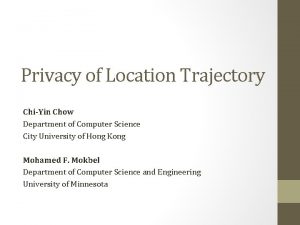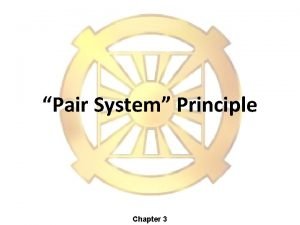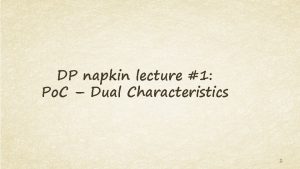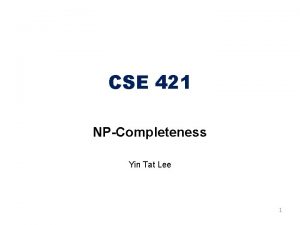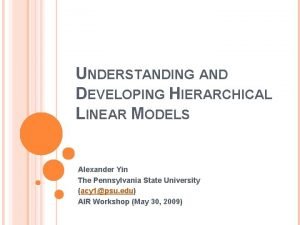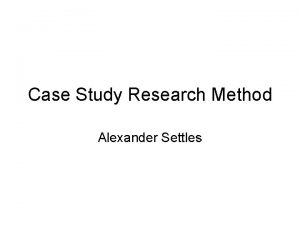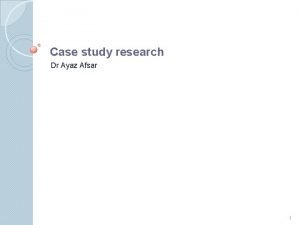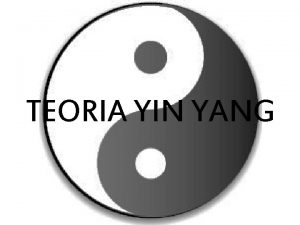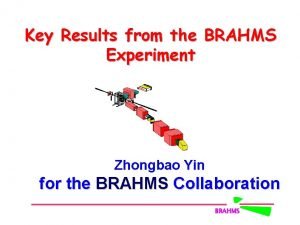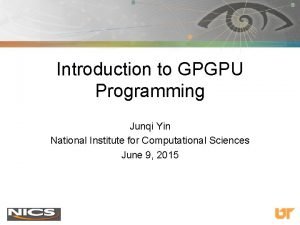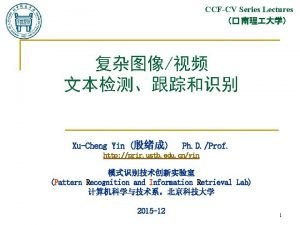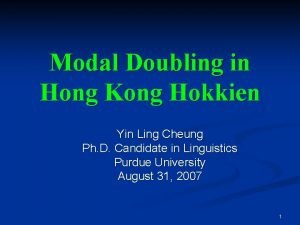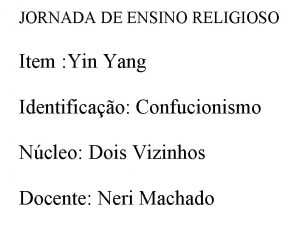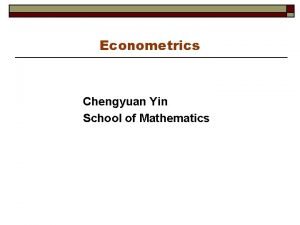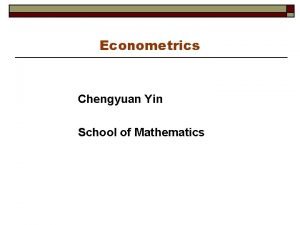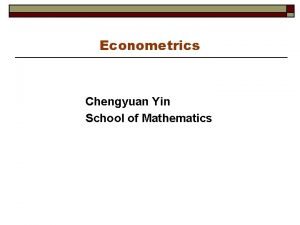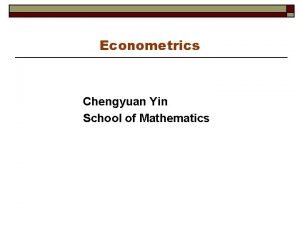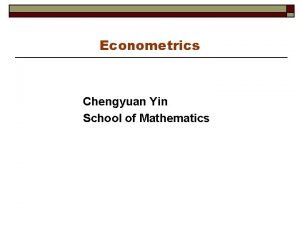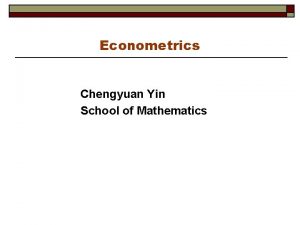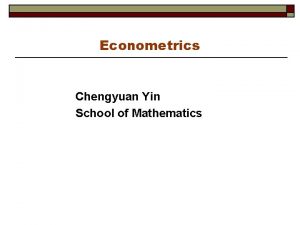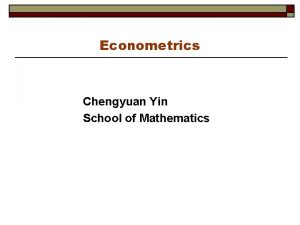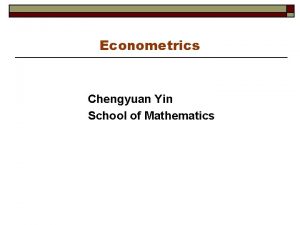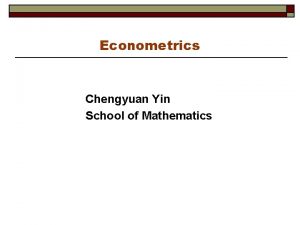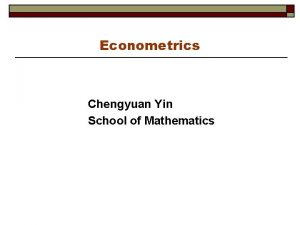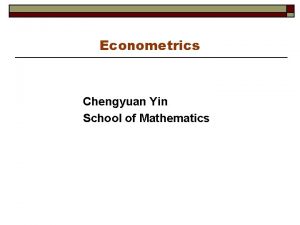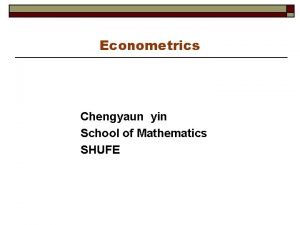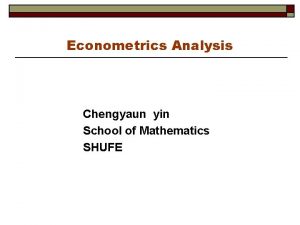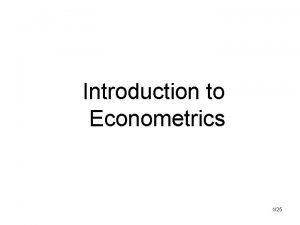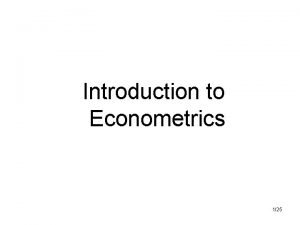Econometrics Chengyuan Yin School of Mathematics Econometrics 26


























- Slides: 26

Econometrics Chengyuan Yin School of Mathematics

Econometrics 26. Time Series Data

Modeling an Economic Time Series o o Observed y 0, y 1, …, yt, … What is the “sample” Random sampling? The “observation window”

Estimators o o Functions of sums of observations Law of large numbers? n n o Nonindependent observations What does “increasing sample size” mean? Asymptotic properties? (There are no finite sample properties. )

Interpreting a Time Series o Time domain: A “process” n n o Frequency domain: A sum of terms n n o y(t) = ax(t) + by(t-1) + … Regression like approach/interpretation y(t) = Contribution of different frequencies to the observed series. (“High frequency data and financial econometrics – “frequency” is used slightly differently here. )

For example, …

In parts…

Studying the Frequency Domain o o o Cannot identify the number of terms Cannot identify frequencies from the time series Deconstructing the variance, autocovariances and autocorrelations n n Contributions at different frequencies Apparent large weights at different frequencies Using Fourier transforms of the data Does this provide “new” information about the series?

Autocorrelation in Regression o Yt = b’xt + εt Cov(εt, εt-1) ≠ 0 o Ex. Real. Const = a + b. Real. Income + εt U. S. Data, quarterly, 1950 -2000 o

Autocorrelation o o o How does it arise? What does it mean? Modeling approaches n Classical – direct: “Corrective” o o n Estimation that accounts for autocorrelation Inference in the presence of autocorrelation Contemporary – structural o o Model the source Incorporate the time series aspect in the model

Stationary Time Series o o zt = b 1 yt-1 + b 2 yt-2 + … + b. Pyt-P + et Autocovariance: γk = Cov[yt, yt-k] Autocorrelation: k = γk / γ 0 Stationary series: γk depends only on k, not on t n n o Weak stationarity: E[yt] is not a function of t, E[yt * yt-s] is not a function of t or s, only of |t-s| Strong stationarity: The joint distribution of [yt, yt-1, …, yt-s] for any window of length s periods, is not a function of t or s. A condition for weak stationarity: The smallest root of the characteristic polynomial: 1 - b 1 z 1 - b 2 z 2 - … - b. Pz. P = 0, is greater than one. n n n The unit circle Complex roots Example: yt = yt-1 + ee, 1 - z = 0 has root z = 1/ , | z | > 1 => | | < 1.

Stationary vs. Nonstationary Series

The Lag Operator o o o Lxt = xt-1 L 2 xt = xt-2 LPxt + LQxt = xt-P + xt-Q Polynomials in L: yt = B(L)yt + et A(L) yt = et Invertibility: yt = [A(L)]-1 et

Inverting a Stationary Series o o yt= yt-1 + et (1 - L)yt = et yt = [1 - L]-1 et = et + et-1 + 2 et-2 + … n n Stationary series can be inverted Autoregressive vs. moving average form of series

Regression with Autocorrelation o o yt = xt’b + et, et = et-1 + ut (1 - L)et = ut et = (1 - L)-1 ut n E[et] = E[ (1 - L)-1 ut] = (1 - L)-1 E[ut] = 0 n Var[et] = (1 - L)-2 Var[ut] = 1+ 2 u 2 + … = u 2/(1 - 2) n Cov[et, et-1] = Cov[ et-1 + ut, et-1] = = Cov[et-1, et-1]+Cov[ut, et-1] = u 2/(1 - 2)

OLS vs. GLS o OLS n n n o Unbiased? Consistent: (Except in the presence of a lagged dependent variable) Inefficient GLS n Consistent and efficient

+--------------------------+ | Ordinary least squares regression | | LHS=REALCONS Mean = 2999. 436 | | Autocorrel Durbin-Watson Stat. =. 0920480 | | Rho = cor[e, e(-1)] =. 9539760 | +--------------------------+ +--------------+--------+---------+-----+ |Variable | Coefficient | Standard Error |t-ratio |P[|T|>t] | Mean of X| +--------------+--------+---------+-----+ Constant -80. 3547488 14. 3058515 -5. 617. 0000 REALDPI. 92168567. 00387175 238. 054. 0000 3341. 47598 | Robust VC Newey-West, Periods = 10 | +--------------+--------+---------+-----+ |Variable | Coefficient | Standard Error |t-ratio |P[|T|>t] | Mean of X| +--------------+--------+---------+-----+ Constant -80. 3547488 41. 7239214 -1. 926. 0555 REALDPI. 92168567. 01503516 61. 302. 0000 3341. 47598 +-----------------------+ | AR(1) Model: e(t) = rho * e(t-1) + u(t) | | Final value of Rho =. 998782 | | Iter= 6, SS= 118367. 007, Log-L=-941. 371914 | | Durbin-Watson: e(t) =. 002436 | | Std. Deviation: e(t) = 490. 567910 | | Std. Deviation: u(t) = 24. 206926 | | Durbin-Watson: u(t) = 1. 994957 | | Autocorrelation: u(t) =. 002521 | | N[0, 1] used for significance levels | +-----------------------+ +--------------+--------+---------+-----+ |Variable | Coefficient | Standard Error |b/St. Er. |P[|Z|>z] | Mean of X| +--------------+--------+---------+-----+ Constant 1019. 32680 411. 177156 2. 479. 0132 REALDPI. 67342731. 03972593 16. 952. 0000 3341. 47598 RHO. 99878181. 00346332 288. 389. 0000

Detecting Autocorrelation o Use residuals n n o Durbin-Watson d= Assumes normally distributed disturbances strictly exogenous regressors Variable addition (Godfrey) n n n yt = ’xt + εt-1 + ut Use regression residuals et and test = 0 Assumes consistency of b.

A Unit Root? o o How to test for = 1? By construction: εt – εt-1 = ( - 1)εt-1 + ut n n n o Test for γ = ( - 1) = 0 using regression? Variance goes to 0 faster than 1/T. Need a new table; can’t use standard t tables. Dickey – Fuller tests Unit roots in economic data. (Are there? ) n n Nonstationary series Implications for conventional analysis

Reinterpreting Autocorrelation

Integrated Processes o o Integration of order (P) when the P’th differenced series is stationary Stationary series are I(0) Trending series are often I(1). Then yt – yt-1 = yt is I(0). [Most macroeconomic data series. ] Accelerating series might be I(2). Then (yt – yt-1)- (yt – yt-1) = 2 yt is I(0) [Money stock in hyperinflationary economies. Difficult to find many applications in economics]

Real DPI and Real Consumption

Cointegration – Divergent Series?

Cointegration o o o o X(t) and y(t) are obviously I(1) Looks like any linear combination of x(t) and y(t) will also be I(1) Does a model y(t) = bx(t) + u(u) where u(t) is I(0) make any sense? How can u(t) be I(0)? In fact, there is a linear combination, [1, - ] that is I(0). y(t) =. 1*t + noise, x(t) =. 2*t + noise y(t) and x(t) have a common trend y(t) and x(t) are cointegrated.

Cointegration and I(0) Residuals

The End
 Yin yang marketing
Yin yang marketing Chi-yin chow
Chi-yin chow Pleasure principle chapter 3
Pleasure principle chapter 3 O yin turlari ppt
O yin turlari ppt Bolalarga harf o'rgatish
Bolalarga harf o'rgatish Meridianos yin
Meridianos yin Yin e yang masculino e feminino
Yin e yang masculino e feminino Yin energy characteristics
Yin energy characteristics Yin tat lee
Yin tat lee Chapylines
Chapylines Alexander yin
Alexander yin Mike yin new zealand
Mike yin new zealand Wenyan yin
Wenyan yin Robert yin case study
Robert yin case study Conclusion of case study
Conclusion of case study Teoria yin yang
Teoria yin yang Hui yin
Hui yin Yin
Yin Junqi yin
Junqi yin Fallstudie fördelar och nackdelar
Fallstudie fördelar och nackdelar Ccfcv
Ccfcv Taoismo
Taoismo Wong wai yin
Wong wai yin Muskul kuchini aniqlaydigan asbob
Muskul kuchini aniqlaydigan asbob Cheung yin ling
Cheung yin ling Yin significado
Yin significado Qi deficiency tongue pictures
Qi deficiency tongue pictures

